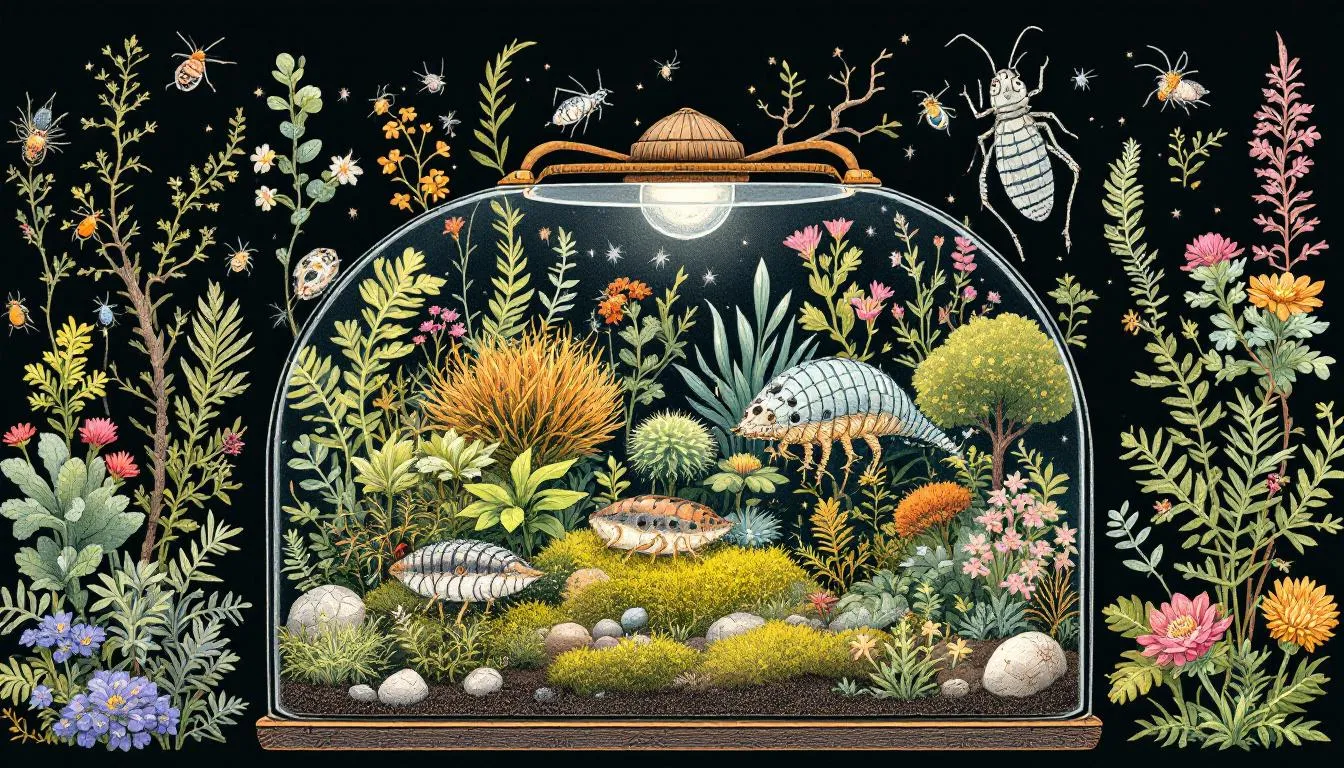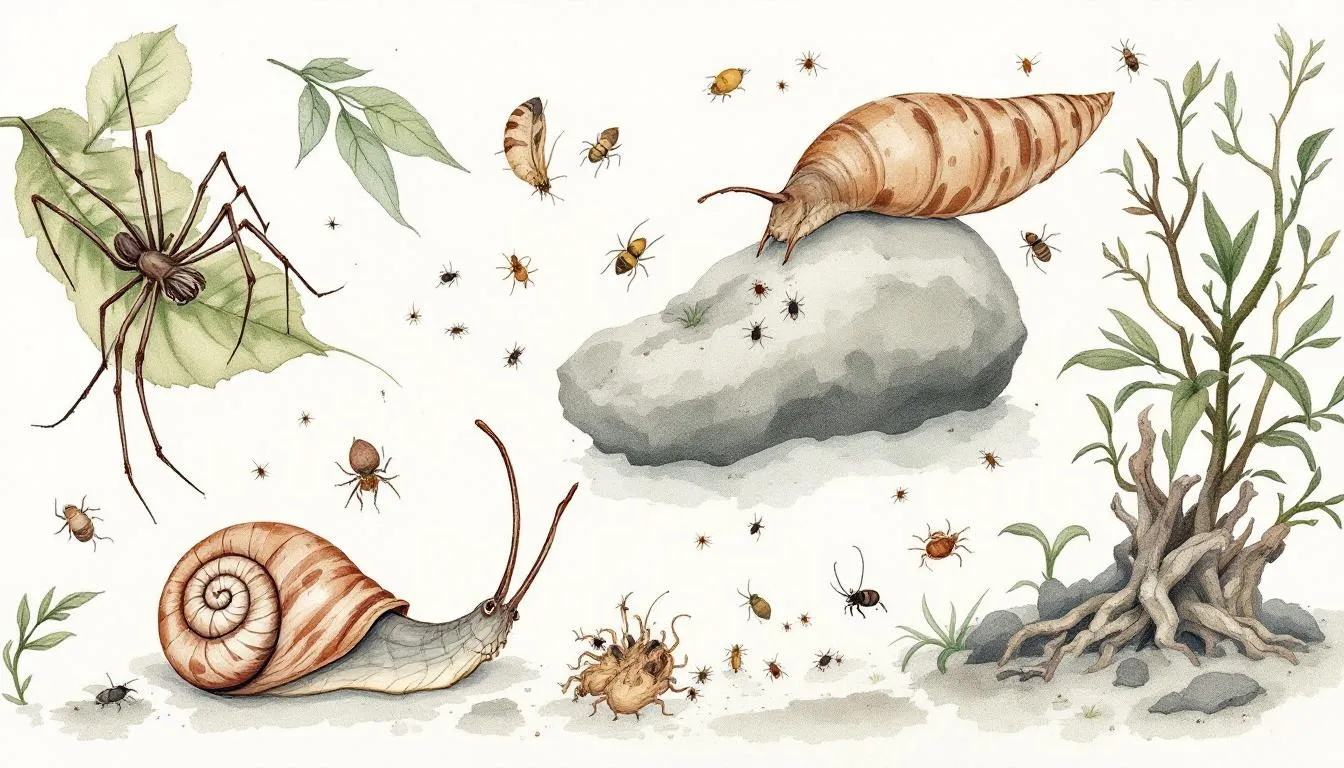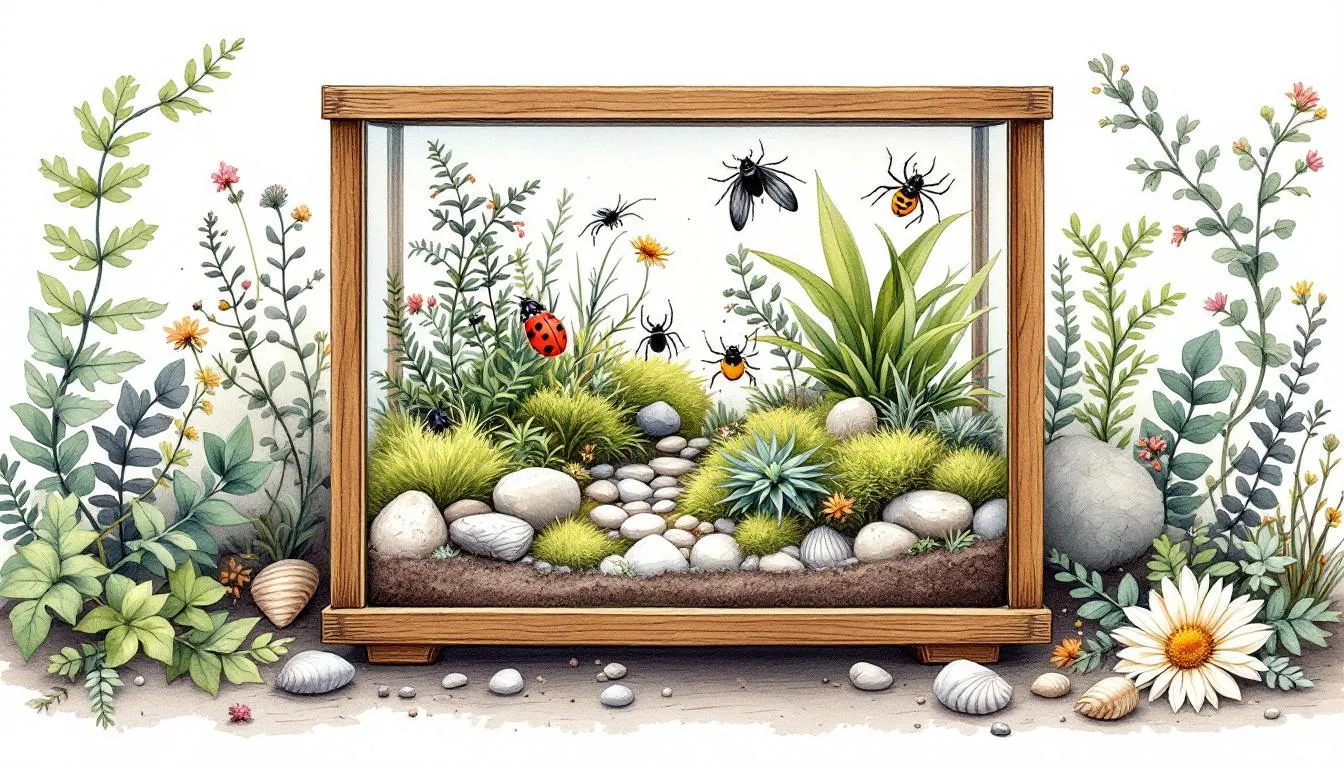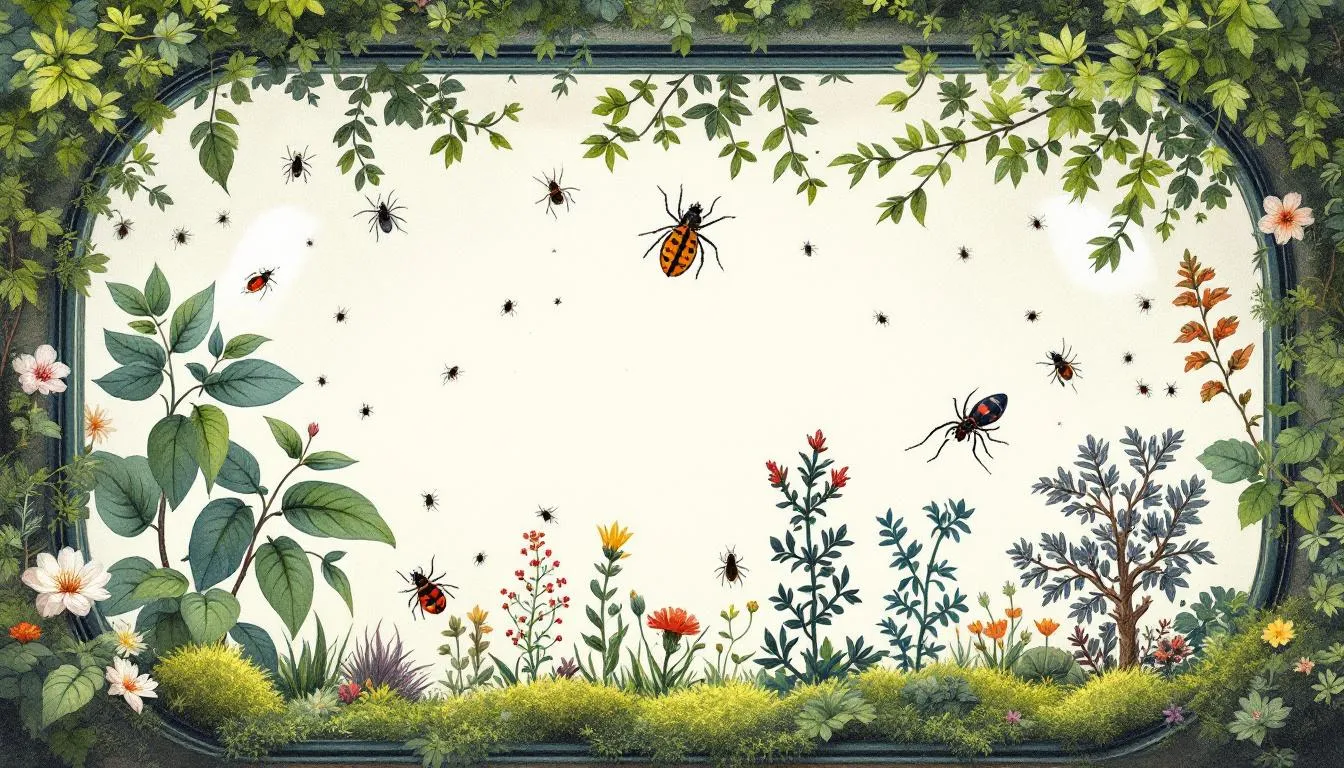Top Terrarium Bugs: 10 Species to Thrive or Avoid in Your Setup
Terrarium bugs play a crucial role in maintaining a healthy terrarium ecosystem. In this article, we’ll explore which bugs you should introduce to your terrarium and which to avoid. We’ll also discuss how to care for and manage them effectively for a thriving setup.
Key Takeaways
-
Beneficial bugs like springtails and isopods enhance terrarium health by managing mold, aerating soil, and decomposing organic matter.
-
Avoid critters like slugs and spiders that can harm plants and disrupt the balance in your terrarium ecosystem.
-
Maintaining proper conditions and breeding methods for beneficial bugs can lead to a thriving, self-sustaining terrarium setup.
Essential Terrarium Bugs for a Balanced Ecosystem

Bugs play a crucial role in keeping terrariums clean, nutrient-rich, and pest-free. Introducing the right insects can create a self-sustaining ecosystem that requires less maintenance over time, making your terrarium a joy to behold and care for. Beneficial bugs help maintain nutrient-rich soil by decomposing organic matter, breaking down waste, and controlling mold growth.
Among the essential bugs, springtails, terrestrial isopods, and earthworms shine the brightest. Each of these critters brings unique benefits to your terrarium:
-
Springtails manage mold issues and support nutrient cycling.
-
Terrestrial isopods, including woodlice, serve as primary decomposers.
-
Earthworms aerate the soil and improve water management.
Let’s delve deeper into each of these awesome bugs and discover how they can enhance your terrarium’s ecosystem.
Springtails: The Tiny Powerhouses
Springtails are effective in managing mold issues and support nutrient cycling by consuming decaying materials. These tiny insects thrive in environments that are dark and moist, which is essential for their breeding success. Maintaining conditions that support springtails populations enhances terrarium health and helps prevent mold growth.
Dark containers are ideal for springtails as they prefer low-light environments for breeding. Creating an environment with limited light and ample moisture ensures a thriving colony of springtails, which will diligently work to keep your terrarium clean and balanced.
Terrestrial Isopods: Nature’s Clean-Up Crew
Isopods, including woodlice, serve as primary decomposers in terrariums by feeding on waste and mold. The benefits of isopods include helping keep the terrarium clean and feeding on detritus. These critters reproduce naturally in terrariums, leading to the stabilization of their populations over time.
Larger varieties of isopods are excellent clean-up crews for bigger terrariums, while tropical species thrive in warm, humid conditions. Whether you have a small or large terrarium, choosing the right species of Isopod can significantly impact the cleanliness and health of your setup.
Earthworms: Soil Aerators
Earthworms play a critical role in aerating soil and can reach difficult areas within the terrarium. They:
-
Help loosen the substrate
-
Prevent compaction
-
Improve access to air and oxygen for plant roots
-
Prevent solid block formation, enhancing water management in the terrarium.
Earthworms reproduce easily and can be especially valuable in larger terrarium projects. Including these worms in your terrarium can result in healthier plants with better root systems and more efficient nutrient uptake.
Additional Beneficial Critters for Your Terrarium

Beyond the essential bugs, there are additional critters that can further enrich your terrarium ecosystem. Bugs in terrariums help break down organic matter, making nutrients accessible for plants. These critters, such as snails and millipedes, play vital roles in maintaining a balanced and healthy environment.
Springtails are classified as Entognatha and thrive in terrarium environments. Typically smaller than 1 cm, they have a detritivorous diet, feeding on decaying organic matter. Let’s explore the roles of snails and millipedes in more detail.
Snails: Natural Decomposers
Snails play a vital role in a terrarium by eating dead leaves and fungal spores. To maintain their shells, snails require a high calcium content in their diet. You can enrich the substrate for snails by using crushed mussel shells, hard water, or herbal soil.
These natural decomposers help break down organic matter and decaying matter, making nutrients available for plants and contributing to a balanced terrarium ecosystem. Just make sure to provide them with the calcium they need to keep their shells healthy and strong to rest.
Millipedes: Efficient Detritivores
Millipedes thrive on plant debris and help break down organic materials efficiently. A deep substrate layer is essential for millipedes to burrow and find food. These critters are excellent detritivores, playing a crucial role in the decomposition process and nutrient cycling within the terrarium.
Including millipedes in your terrarium not only helps keep it clean but also ensures that organic matter is continuously broken down, providing a steady supply of nutrients for your plants.
Critters to Avoid in Your Terrarium

While many bugs are beneficial, it’s crucial to identify critters that may harm your terrarium setup. Avoiding certain insects and animals can help maintain a healthy environment for your plants and other beneficial bugs.
Carnivores insects such as praying mantises and ladybugs could cause collateral damage in a terrarium. Additionally, while valuable for larger terrariums, earthworms can create messes in smaller setups due to their organic material consumption.
Let’s take a closer look at some specific annoying critters to completely note and personally worry jump avoid.
Spiders: Predatory Challenges
Spiders can be included in a terrarium, but only in a spider-specific terrarium. They can thrive if provided with a targeted environment. However, spiders pose challenges in terrariums primarily due to their dietary needs and the potential for causing decay.
Spiders can trap and consume beneficial bugs, making them a threat in a general terrarium setup. While they can be fascinating pets, their predatory nature makes them unsuitable for a balanced terrarium ecosystem.
Slugs and Beetles: Potential Plant Eaters
Slugs can severely damage or consume delicate plants in a terrarium. Similarly, beetles may consume plants, making it crucial to choose plant species that are less appealing to these pests.
Including slugs and beetles in your terrarium can lead to unsightly damage and potential nutrient loss for your plants. It’s best to avoid these critters to maintain the health and aesthetics of your terrarium.
Cultivating and Maintaining Terrarium Bugs

Cultivating and maintaining beneficial bugs is essential for creating an interesting and thriving terrarium ecosystem. Isopods, including woodlice actively feed on decomposing wood waste and contribute to soil nutrient enrichment while crawling through the substrate.
In this section, we’ll explore how to breed springtails and keep isopods happy, ensuring your terrarium remains a healthy and vibrant environment.
Breeding Springtails
Breeding springtails involves using a dark container filled with water and activated carbon. Activated carbon in springtail cultures maintains water quality and reduces mold growth.
Springtails are relatively easy to breed, and maintaining their population can significantly enhance your terrarium’s health by preventing mold and promoting nutrient cycling.
Keeping Isopods Happy
Using a substrate mix that includes leaf litter can create a natural habitat for isopods to thrive. Isopods require a terrarium of at least one gallon to ensure they have enough space and forage. Maintaining high humidity is crucial for their well-being.
It’s also important to ensure that any leaves provided as food are sourced from untreated areas to avoid chemical exposure. Overpopulation of isopods can occur if they are cared for too well, necessitating the creation of additional habitats.
Common Terrarium Pests and How to Manage Them

Common pests found in terrariums include gnats, mites, and mealybugs. These pests can cause various negative effects on plants, ranging from minor issues to serious damage that can sap plant vitality.
If pests are found in a terrarium, quarantine the affected plants, swap out substrates, or consider starting over to manage the outbreak. The presence of beneficial bugs can help prevent pest outbreaks by consuming organic waste that might attract harmful pests.
Do You Really Need Bugs in Your Terrarium?
Bugs contribute significantly to a terrarium’s ecosystem by maintaining nutrient cycles through decomposition and controlling mold. While bugs are beneficial for ecological balance, they are not strictly necessary for a terrarium to thrive.
In a closed terrarium, populations of insects can self-regulate due to fixed resource availability. Millipedes, as detritivores, help break down plant debris, and eventually, effective breeding of bugs can enhance a self sufficient ecosystem.
Summary
In summary, incorporating beneficial bugs like springtails, terrestrial isopods, and earthworms can create a thriving, self-sustaining ecosystem in your terrarium. Additional critters like snails and millipedes further enrich the environment by breaking down organic matter and contributing to nutrient cycles.
Avoiding harmful critters such as spiders, slugs, and beetles is crucial for maintaining a healthy terrarium. Cultivating and maintaining beneficial bugs ensures your terrarium remains balanced and vibrant. Embrace the tiny powerhouses and watch your terrarium flourish!
Frequently Asked Questions
Why are bugs important in a terrarium?
Bugs are super important in a terrarium because they help break down organic matter, keep it clean, and control mold. Without them, your little ecosystem wouldn’t thrive!
Can I include spiders in my terrarium?
You can add spiders to your terrarium, but it's best to create a setup just for them since they're predators and can disrupt a balanced ecosystem. Just make sure they're compatible with the environment you've got!
How do I breed springtails for my terrarium?
To breed springtails, just set up a dark container with water and activated carbon to keep the water clean and minimize mold. It’s an easy way to cultivate a healthy springtail population for your terrarium!
What should I avoid including in my terrarium?
Skip adding carnivorous insects like praying mantises and ladybugs, plus any plant-eating pests like slugs and beetles, to keep your terrarium healthy. Trust me, it's better without those guys!
Do I really need bugs in my terrarium?
You don’t really need bugs in your terrarium; they can help with nutrients and mold control, but your plants can thrive just fine without them.







